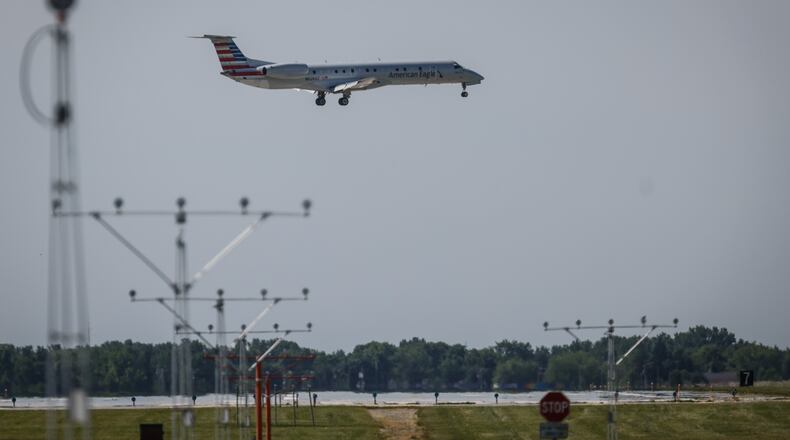The biggest increases in airfare are in smaller markets. Dayton’s rise in airfare was followed by Flint, Mich. (38%), Greensboro, N.C. (38%), Des Moines, Iowa (36%) and Spokane, Wash. (35%). Cincinnati/Northern Kentucky International Airport, came in at 34%, or about $79 more for each airline ticket.
“Clearly, the driving force for Dayton landing where they did in that is the fact that they’re seeing a decreased number of seats, probably the low-cost carrier seats,” aviation expert Jay Ratliff told this news outlet. “If they have fewer of those than they did the year before, you can count on the prices going up.”
Any reduction in the number of seats going in or out of an airport means what is left are going to be offered for a premium price, Ratliff said.
Smaller airports, servicing smaller metropolitan areas have the largest fare spikes, while the larger airports with more traffic and a higher airfare saw airfare increases as well, just not to the extent of the smaller cities, according to the study.
One of the problem’s the nation is facing this year, and especially as spring turns to summer, is a dramatic increase in the demand for travel, Ratliff said. In addition, airlines are canceling tens of thousands of flights because they don’t have the staffing to operate them, he said.
That shortage of staff is contributing to some “unbelievable operational nightmares” for airlines, he said.
“You really have the perfect storm for these fares not only going up as we’ve seen year over years, (but) this is going to continue,” Ratliff said. “It’s going to get a lot worse before it gets better.”
Canceling flights at the very time airlines most look forward to, a summer season during which they make more money than in any other time of the year, is telling, but to see tens of thousands of them canceled “is really reflective of just how bad things are,” he said.
Airlines, at the start of the pandemic, saw demand drop by 95%, Ratliff said. That led them to reduce their workforce, especially staffers with larger salaries, in order to provide some monetary relief. Now, with travel ramping up again, they’re struggling to fill replacements, he said.
“The one thing nobody predicted is nobody wanted to work,” Ratliff said. “Southwest would put out an opening online and for every opening, they used to get 100 to 150 interested applicants. They put something out now, they’re getting nine, 10, 15 (applicants), so it gets shocking to see how much disinterest that there is right now in working in this industry and that’s one of the operational issues airlines are having: the demand for travel is soaring, but they don’t have enough people to work the flight.”
While business travel is starting to rebound, it’s nowhere near where it was at the start of the pandemic, Ratliff said.
But as summer draws closer, with the increased fares and a lot of people traveling for leisure or vacation, the increased airfares are not slowing a lot of people down, he said.
Dayton International Airport offers commercial service on four airlines — Allegiant Air, American Airlines, Delta Air Lines, and United Airlines — and in a typical year transports about 1 million passengers. In 2021, it ranked at just 130th on a list of the country’s busiest airports, according to Stratos Jet Charters.
Linda Hughes, the airport’s spokeswoman, said a look at the scheduled flights in June 2021 shows it had 978 monthly flights then compared to the 884 flights scheduled for the month.
“Flight schedules and capacity changes often, sometimes weekly,” Hughes said. “These numbers are very fluid.”
As an industry trend, the airlines are working to decrease the size of smaller aircraft to fly a more energy efficient aircraft, however “we haven’t seen great differences in Dayton as of yet,” she said.
Smaller flight markets like Dayton show larger fare increases because of the limited number of flights and airlines operating out of some of these airports, according to the study.
In addition to staffing shortages, increased demand and rising gas prices also contributed to airfare jumping more than 18.6% in the United States in April, the sharpest single month increase since the Bureau of Labor Statistics started tracking costs in 1963, according to the agency. That built on a months-long trend that has seen airfare prices increase 33.3% over the last year, the largest 1-year increase since 1980, according to the bureau’s Consumer Price Index for All Urban Consumers.
Hughes said all Daytonians can play “a huge role” in helping to attract more airlines and more air service to the Dayton International Airport.
“By flying out of our local airport, we send an important message to the airlines that this community supports the service they are already providing, and they will add more service,” she said. “Airlines add flights where they see passengers boarding flights.”
Hughes said airport administration actively visits and presents to local businesses, rotary clubs, chambers of commerce and professional organizations to provide updates on the airline industry and Dayton Airport.
“Years ago, a Corporate Airport Advisory Group was initiated made up of community leaders and large companies within our community to assist in our communications with the airlines,” Hughes said.
About the Author



